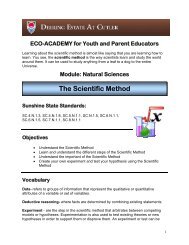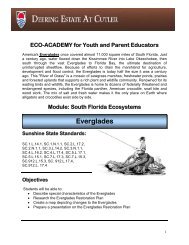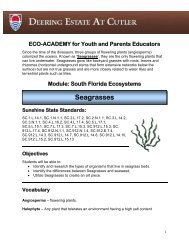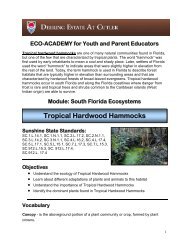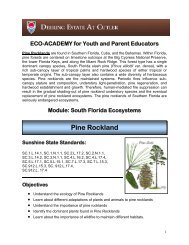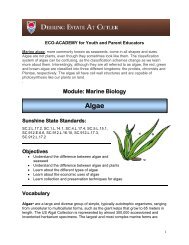Salt Marshes Lesson Plan - Deering Estate at Cutler
Salt Marshes Lesson Plan - Deering Estate at Cutler
Salt Marshes Lesson Plan - Deering Estate at Cutler
You also want an ePaper? Increase the reach of your titles
YUMPU automatically turns print PDFs into web optimized ePapers that Google loves.
the Avon-He<strong>at</strong>hcote Estuary in Christchurch. Back-barrier marshes are sensitive to the<br />
reshaping of barriers in the landward side of which they have been formed. They are<br />
common along much of the eastern coast of the United St<strong>at</strong>es and the Frisian Islands.<br />
Large, shallow coastal embayments can hold salt marshes with examples including<br />
Morecambe Bay and Portsmouth in Britain and the Bay of Fundy in North America.<br />
Tidal flooding and veget<strong>at</strong>ion zon<strong>at</strong>ion<br />
Coastal salt marshes can be distinguished from terrestrial habit<strong>at</strong>s by the daily tidal flow<br />
th<strong>at</strong> occurs and continuously floods the area. It is an important process in delivering<br />
sediments, nutrients and plant w<strong>at</strong>er supply to the marsh. At higher elev<strong>at</strong>ions in the<br />
upper marsh zone, there is much less tidal inflow, resulting in lower salinity levels. Soil<br />
salinity in the lower marsh zone is fairly constant due to everyday annual tidal flow.<br />
However, in the upper marsh, variability in salinity is shown as a result of less frequent<br />
flooding and clim<strong>at</strong>e vari<strong>at</strong>ions. Rainfall can reduce salinity and evapotranspir<strong>at</strong>ion can<br />
increase levels during dry periods. As a result, there are microhabit<strong>at</strong>s popul<strong>at</strong>ed by<br />
different species of flora and fauna dependant on their physiological abilities. The flora<br />
of a salt marsh is differenti<strong>at</strong>ed into levels according to the plants' individual tolerance of<br />
salinity and w<strong>at</strong>er table levels. Veget<strong>at</strong>ion found <strong>at</strong> the w<strong>at</strong>er must be able to survive<br />
high salt concentr<strong>at</strong>ions, periodical submersion, and a certain amount of w<strong>at</strong>er<br />
movement, while plants further inland in the marsh can sometimes experience dry, lownutrient<br />
conditions. It has been found th<strong>at</strong> the upper marsh zones limit species through<br />
competition and the lack of habit<strong>at</strong> protection, while lower marsh zones are determined<br />
through the ability of plants to toler<strong>at</strong>e physiological stresses such as salinity, w<strong>at</strong>er<br />
submergence and low oxygen levels.





